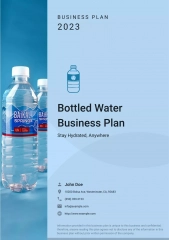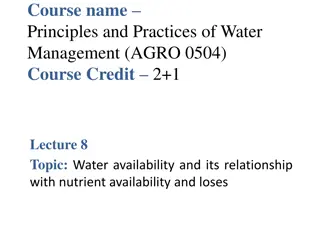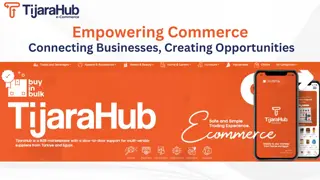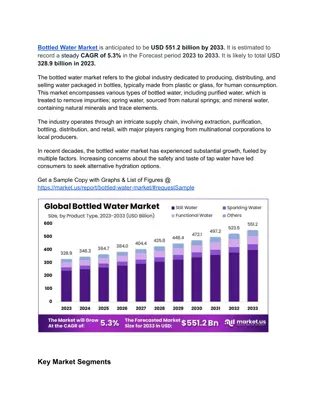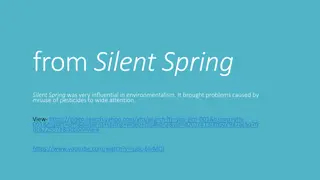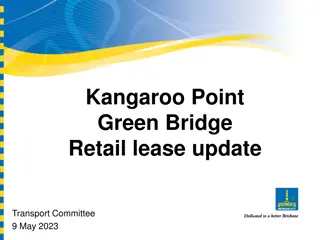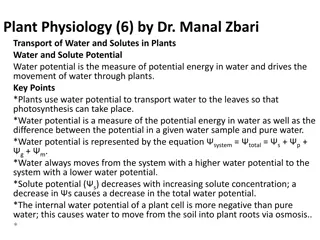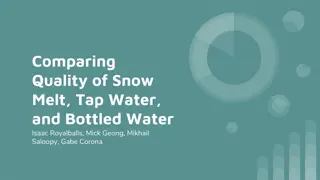The Rising Trend of Bottled Water in the American Beverage Market
Americans' consumption of bottled water surged in 2018, marking a significant shift from carbonated drinks. Health benefits and innovative products like CBD-infused water are driving the market growth, with forecasts indicating further increases in per capita consumption and total sales by 2022.
Download Presentation

Please find below an Image/Link to download the presentation.
The content on the website is provided AS IS for your information and personal use only. It may not be sold, licensed, or shared on other websites without obtaining consent from the author.If you encounter any issues during the download, it is possible that the publisher has removed the file from their server.
You are allowed to download the files provided on this website for personal or commercial use, subject to the condition that they are used lawfully. All files are the property of their respective owners.
The content on the website is provided AS IS for your information and personal use only. It may not be sold, licensed, or shared on other websites without obtaining consent from the author.
E N D
Presentation Transcript
Flooding the Beverage Market The latest data from the Beverage Marketing Corporation (BMC) indicates Americans consumed almost 14 billion gallons of bottled water during 2018, a 4.7% increase from 2017, with wholesale dollar sales increasing 7.3%, to $18.4 billion. BMC also reported 69% of the increasing consumption of bottled water continues the decline of carbonated soft drinks (CSDs), 2018 being the 14thconsecutive year of decreasing consumption. Even diet CSDs had flat sales during 2018. Per capita consumption of bottled water increased 6.2% during 2018, or more than 42 gallons and BMC forecasts per capita consumption will total 50 gallons within a few years and $23.9 billion in total sales by 2022.
To Your Health The health benefits of bottled water (and any form of water) continues to be the primary driver of increased consumption and sales. The International Bottled Water Association (IBWA) reported Americans may have reduced their 2018 calorie count by 470 billion. According to a new George Washington University study, drinking low- or zero-calorie sweetened beverages caused children to ingest 200 additional calories per day compared to those who drank water. Signals Analytics, in its white paper, The Reshaping of Water, stated consumers are attracted to enhanced water, or those with added or naturally occurring vitamins and minerals, as they perceive these products as positive for mental health.
Still Water Is a Very Active Segment Still bottled water dollars sales at US supermarkets, drug stores, gas and convenience stores, mass merchandisers, military commissaries and select club and dollar store chains totaled $11.87 billion for the 52 weeks ending 5/20/18, a 3.3% YOY increase. Total sales and YOY change increased again for the 52 weeks ending 8/12/18, or $12.13 billion and a 5.6% increase from the 52 weeks ending 8/12/17. Jug/bulk still bottled water increased 3.9% YOY and totaled $1.52 billion for the 52 weeks ending 5/20/18. In its August 2018 report, BMC forecast a 4.8% CAGR (compound annual growth rate) through 2022, which would represent 69.5% of total bottled water volume.
Bubbly Bonanza The seltzer/sparkling/mineral bottled water market sector increased by double digits for the 52 weeks ending 5/20/18, or 13.5%, to total dollar sales of $2.65 billion. The sector continued to increase by double digits for the 52 weeks ending 8/12/18, or a YOY change of 15.0% and $2.76 billion in total dollar sales. BMC is predicting domestic sparking water s share will more than double from 2017 to 2022, or 2.1% and 4.6%, respectively, while imported water in this sector will increase at a more modest 0.4%.
CBD-Infused Bottled Water Hits the Market With more states legalizing medicinal and recreational cannabis, CBD products, (which don t include THC), primarily in the form of topical items, are becoming popular and are being added to the inventory of major retailers, such as Kroger, Walgreens and others. Although the FDA won t allow CBD to be added to food products, there are an increasing number of CBD-infused bottled water brands and Cowen and Company forecasts this segment will total $600 million in 2019 sales and almost $1 billion by 2020. CBD-infused bottled water products, such as Recess and Alkaline88, are available, but the manufacturers are being careful with their marketing efforts and product descriptions as they try to navigate the gray areas of FDA pronouncements.
Attempts to Save the Environment from More Water Bottles According to the IBWA, bottled water in 16.9oz bottles uses 59% less PET plastic than other beverages and the National Association for PET Container Resources said 53.9% of the bottles are recycled, the most of any product. Despite those welcoming statistics, plastic bottles are not biodegradable; their production and transportation require considerable fossil fuels, estimated at 76 million barrels of oil annually; and more of this and other plastic is being found in the oceans. Bottled-water manufacturers are taking steps, however, as Poland Spring announced during June 2019 that it would use 100% recycled plastic for its bottles by 2022 and Danone said the same, but by 2025, for its Evian water brand.
Advertising Strategies Local retailers/advertisers who sell bottled water have an opportunity to be proactive about the environmental impact of plastic bottles by promoting a one-week or longer period of accepting empty bottles for recycling in exchange for a coupon or a free reusable bottle. Seltzer, sparkling and mineral bottled water is a hot, but small segment of the overall market, but it s another opportunity for local retailers/advertisers to attract more consumers to the product with a limited-time coupon/discount. Another opportunity for local retailers/advertisers to help reduce the amount of plastic bottles and not hurt sales is to promote water in cans, especially sparkling water brands.
New Media Strategies Retailers/advertisers who sell bottled water can use social media to promote maximum recycling, inviting customers to post short videos about what they do to recycle plastic bottles. Retailers/advertisers who sell bottled water can also partner with local recycling centers to help maximize plastic bottle recycling and create content for social media posts demonstrating their involvement to improve the community. Ask customers to serve as microinfluencers and/or post short videos about how drinking bottled water has improved their health, both physical and mental.


